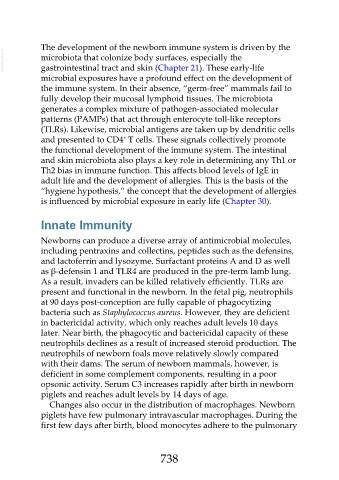Page 738 - Veterinary Immunology, 10th Edition
P. 738
The development of the newborn immune system is driven by the
VetBooks.ir microbiota that colonize body surfaces, especially the
gastrointestinal tract and skin (Chapter 21). These early-life
microbial exposures have a profound effect on the development of
the immune system. In their absence, “germ-free” mammals fail to
fully develop their mucosal lymphoid tissues. The microbiota
generates a complex mixture of pathogen-associated molecular
patterns (PAMPs) that act through enterocyte toll-like receptors
(TLRs). Likewise, microbial antigens are taken up by dendritic cells
+
and presented to CD4 T cells. These signals collectively promote
the functional development of the immune system. The intestinal
and skin microbiota also plays a key role in determining any Th1 or
Th2 bias in immune function. This affects blood levels of IgE in
adult life and the development of allergies. This is the basis of the
“hygiene hypothesis,” the concept that the development of allergies
is influenced by microbial exposure in early life (Chapter 30).
Innate Immunity
Newborns can produce a diverse array of antimicrobial molecules,
including pentraxins and collectins, peptides such as the defensins,
and lactoferrin and lysozyme. Surfactant proteins A and D as well
as β-defensin 1 and TLR4 are produced in the pre-term lamb lung.
As a result, invaders can be killed relatively efficiently. TLRs are
present and functional in the newborn. In the fetal pig, neutrophils
at 90 days post-conception are fully capable of phagocytizing
bacteria such as Staphylococcus aureus. However, they are deficient
in bactericidal activity, which only reaches adult levels 10 days
later. Near birth, the phagocytic and bactericidal capacity of these
neutrophils declines as a result of increased steroid production. The
neutrophils of newborn foals move relatively slowly compared
with their dams. The serum of newborn mammals, however, is
deficient in some complement components, resulting in a poor
opsonic activity. Serum C3 increases rapidly after birth in newborn
piglets and reaches adult levels by 14 days of age.
Changes also occur in the distribution of macrophages. Newborn
piglets have few pulmonary intravascular macrophages. During the
first few days after birth, blood monocytes adhere to the pulmonary
738

